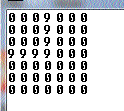假设我有一个以0°旋转存储的数组:
0 0 1 0 0
0 0 1 0 0
1 1 1 0 0
0 0 0 0 0
0 0 0 0 0
如果我通过,我希望它以良好的近似值返回,例如30°作为参数,它将是这样的:
0 0 0 1 0
1 1 0 1 0
0 0 1 0 0
0 0 0 0 0
0 0 0 0 0
45°会
1 0 0 0 1
0 1 0 1 0
0 0 1 0 0
0 0 0 0 0
0 0 0 0 0
I am aware of the solutions posted for 90° rotations.但我认为这不会对我有帮助吗?
我没有任何示例代码,因为我目前甚至不知道从哪里开始查找.如果有任何关键字我可以google指向我的方向我可以适应这个,这也将是伟大的.
class Rotation
{
public Rotation() {
A = new int[xs,ys]{
{0,9,0},{0,{9,};
B = new int[xs,ys];
deg = (float)(Math.PI / 180.0);
}
public const int xs = 7; // matrix size
public const int ys = 7;
const int x0 = 3; // rotation center cell
const int y0 = 3;
readonly float deg;
public int[,] A;
public int[,] B;
//---------------------------------------------------------------------------
public void rotcv(float ang) {
rotcw(Rotation.x0,Rotation.y0,ang);
}
private void rotcw(int x0,int y0,float ang) // rotate A -> B by angle ang around (x0,y0) CW if ang>0
{
int x,y,ix0,iy0,ix1,iy1,q;
double xx,yy,fx,fy,c,s;
// circle kernel
c = Math.Cos(-ang); s = Math.Sin(-ang);
// rotate
for (y = 0; y < ys; y++)
for (x = 0; x < xs; x++)
{
// offset so (0,0) is center of rotation
xx = x - x0;
yy = y - y0;
// rotate (fx,fy) by ang
fx = ((xx * c) - (yy * s));
fy = ((xx * s) + (yy * c));
// offset back and convert to ints and weights
fx += x0; ix0 = (int)Math.Floor(fx); fx -= ix0; ix1 = ix0 + 1; if (ix1 >= xs) ix1 = ix0;
fy += y0; iy0 = (int)Math.Floor (fy); fy -= iy0; iy1 = iy0 + 1; if (iy1 >= ys) iy1 = iy0;
// bilinear interpolation A[fx][fy] -> B[x][y]
if ((ix0 >= 0) && (ix0 < xs) && (iy0 >= 0) && (iy0 < ys))
{
xx = (A[ix0,iy0]) + ((A[ix1,iy0] - A[ix0,iy0]) * fx);
yy = (A[ix0,iy0]) * fx);
xx = xx + ((yy - xx) * fy); q =(int) xx;
}
else q = 0;
B[x,y] = q;
}
}
}
测试:
static void Main(string[] args)
{
Rotation rot = new Rotation();
for (int x = 0; x < Rotation.xs; x++) {
for (int y = 0; y < Rotation.xs; y++) {
Console.Write(rot.A[x,y] + " ");
}
Console.WriteLine();
}
Console.WriteLine();
float rotAngle = 0;
while (true)
{
rotAngle += (float)(Math.PI/180f)*90;
rot.rotcv(rotAngle);
for (int x = 0; x < Rotation.xs; x++)
{
for (int y = 0; y < Rotation.xs; y++)
{
Console.Write(rot.B[x,y] + " ");
}
Console.WriteLine();
}
Console.WriteLine();
Console.ReadLine();
}
}
最佳答案
原文链接:https://www.f2er.com/java/437358.html

